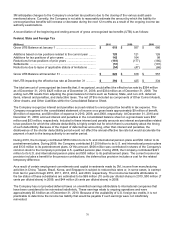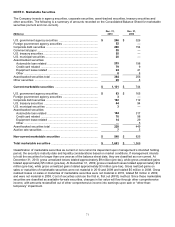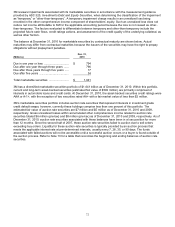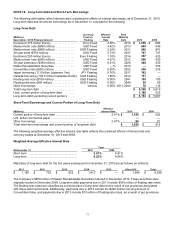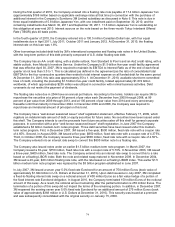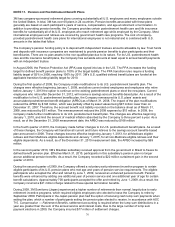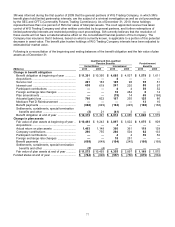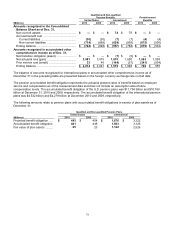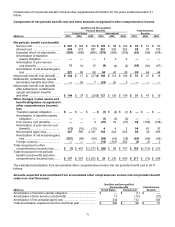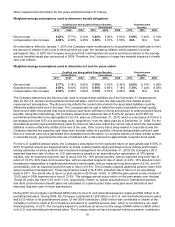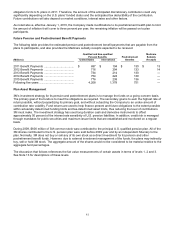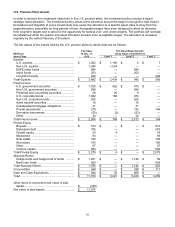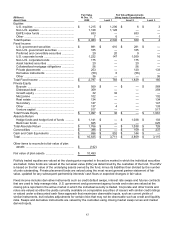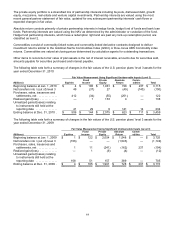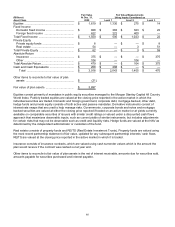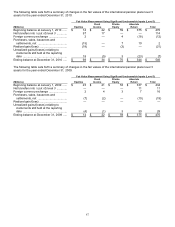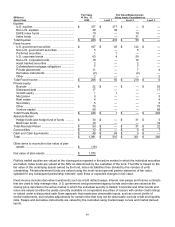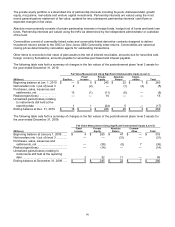3M 2010 Annual Report Download - page 86
Download and view the complete annual report
Please find page 86 of the 2010 3M annual report below. You can navigate through the pages in the report by either clicking on the pages listed below, or by using the keyword search tool below to find specific information within the annual report.
80
Other supplemental information for the years ended December 31 follows:
Weighted-average assumptions used to determine benefit obligations
Qualified
and Non-qualified Pension Benefits
Postretirement
United States
International
Benefits
2010
2009
2008
2010
2009
2008
2010
2009
2008
Discount rate ............
5.23
%
5.77
%
6.14
%
5.04
%
5.30
%
5.53
%
5.09
%
5.62
%
6.14
%
Compensation rate increase
4.00
%
4.30
%
4.30
%
3.59
%
3.72
%
3.50
%
N/A
N/A
N/A
As noted above, effective January 1, 2010, the Company made modifications to its postretirement health plan to limit
the amount of inflation it will cover to three percent per year; the remaining inflation will be passed on to plan
participants. Also, in 2010 the Company announced that it will transition all current and future retirees to the savings
account benefits-based plan announced in 2008. Therefore, the Company no longer has material exposure to health
care cost inflation.
Weighted-average assumptions used to determine net cost for years ended
Qualified and Non-qualified Pension Benefits
Postretirement
United States
International
Benefits
2010
2009
2008
2010
2009
2008
2010
2009
2008
Discount rate ...........
5.77
%
6.14
%
6.00
%
5.30
%
5.53
%
5.39
%
5.62
%
6.14
%
6.00
%
Expected return on assets
8.50
%
8.50
%
8.50
%
6.90
%
6.86
%
7.19
%
7.30
%
7.24
%
8.60
%
Compensation rate increase
4.30
%
4.30
%
4.30
%
3.72
%
3.50
%
3.82
%
N/A
N/A
N/A
The Company determines the discount rate used to measure plan liabilities as of the December 31 measurement
date for the U.S. pension and postretirement benefit plans, which is also the date used for the related annual
measurement assumptions. The discount rate reflects the current rate at which the associated liabilities could be
effectively settled at the end of the year. The Company sets its rate to reflect the yield of a portfolio of high quality,
fixed-income debt instruments that would produce cash flows sufficient in timing and amount to settle projected future
benefits. Using this methodology, the Company determined a discount rate of 5.23% for pension and 5.09% for
postretirement benefits to be appropriate for its U.S. plans as of December 31, 2010, which is a decrease of 0.54 of a
percentage point and 0.53 of a percentage point, respectively, from the rates used as of December 31, 2009. For the
international pension and postretirement plans the discount rates also reflect the current rate at which the associated
liabilities could be effectively settled at the end of the year. If the country has a deep market in corporate bonds the
Company matches the expected cash flows from the plan either to a portfolio of bonds that generate sufficient cash
flow or a notional yield curve generated from available bond information. In countries that do not have a deep market
in corporate bonds, government bonds are considered with a risk premium to approximate corporate bond yields.
For the U.S. qualified pension plans, the Company’s assumption for the expected return on plan assets was 8.50% in
2010. Projected returns are based primarily on broad, publicly traded equity and fixed-income indices and forward-
looking estimates of active portfolio and investment management. As of December 31, 2010, the Company’s 2011
expected long-term rate of return on U.S. plan assets is based on an asset allocation assumption of 37% global
equities, with an expected long-term rate of return of 8.0%; 16% private equities, with an expected long-term rate of
return of 12.0%; 26% fixed-income securities, with an expected long-term rate of return of 4.2%; 16% absolute return
investments independent of traditional performance benchmarks, with an expected long term return of 6.0%; and 5%
commodities, with an expected long-term rate of return of 5.8%. The Company expects additional positive return from
active investment management. These assumptions result in an 8.50% expected rate of return on an annualized
basis in 2011. The actual rate of return on plan assets in 2010 was 14.4%. In 2009 the plan earned a rate of return of
12.6% and in 2008 experienced a loss of 13.6%. The average annual actual return on the plan assets over the past
10 and 25 years has been 6.4% and 11.2%, respectively. Return on assets assumptions for international pension
and other post-retirement benefit plans are calculated on a plan-by-plan basis using plan asset allocations and
expected long-term rate of return assumptions.
During 2010, the Company contributed $556 million to its U.S. and international pension plans and $62 million to its
postretirement plans. During 2009, the Company contributed $1.259 billion to its U.S. and international pension plans
and $133 million to its postretirement plans. Of the 2009 contribution, $600 million was contributed in shares of the
Company’s common stock to the Company’s principal U.S. qualified pension plan, which is considered a non-cash
financing activity. In 2011, the Company expects to contribute an amount in the range of $400 million to $600 million
to its U.S. and international retirement plans. The Company does not have a required minimum pension contribution


